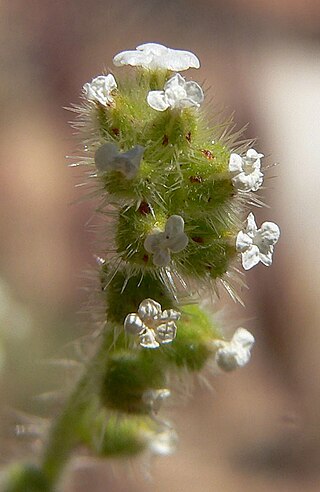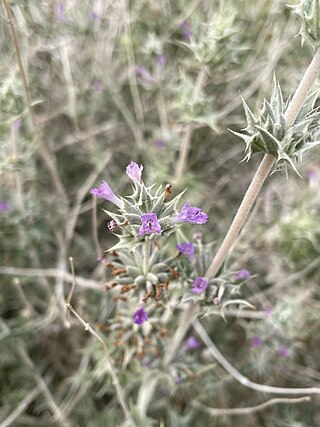
Eremalche rotundifolia, the desert five-spot, is a flowering plant in the family Malvaceae, native to the Mojave Desert and Colorado Desert in the Southwestern United States.

Pectocarya is a plant genus of about 15 species in the family Boraginaceae. Plants in this genus are known generally as combseeds. They are small annual plants which bear tiny white flowers no more than 3 millimeters in diameter. Their fruits are nutlets which often have small projections that look like the teeth of a comb, hence their common name. The nutlets usually come in clusters of four. These plants are found mainly in western North America.

Euphorbia misera is a semi-succulent shrub in the genus Euphorbia commonly known as the cliff spurge or coast spurge. A drought-deciduous shrub, it is typically found as a gnarled, straggly plant occupying seashore bluffs, hills and deserts. Like other members of its genus, it has a milky sap, which can be found exuding out of the light gray bark when damaged. The alternately-arranged leaves are round and folded in the middle, with small hairs on them. The "flowers" can be found blooming year-round, and are colored maroon or yellow in the center with 5 white to light-yellow petal-like appendages attached outside. This species is native to the Baja California peninsula and Sonora in Mexico, and the coast of southern California in the United States, where it is a rare species. It is threatened in some localities by the development of its coastal habitat, which tends to be prime locations for high-end residential and commercial developments.

Astragalus layneae is a species of milkvetch known by the common name widow's milkvetch. It is native to the Mojave Desert and surrounding mountain ridges in California and Nevada.

Echeveria setosa, the Mexican fire cracker, is a species of flowering plant in the family Crassulaceae, native to semi-desert areas of Mexico and common throughout Puebla.
Hackelia setosa is a species of flowering plant in the borage family known by the common name bristly stickseed. It is native to the Klamath Mountains of northern California and southern Oregon, United States, and it is also known from Sierra Valley to the southeast of that range.
Pectocarya heterocarpa is a species of flowering plant in the borage family known by the common names chuckwalla combseed and mixed-nut pectocarya. It is native to the southwestern United States and northern Mexico, where it grows in desert, mountain and plateau habitat, in scrub, woodland, and open areas. This is an annual herb producing a slender, rough-haired stem prostrate or upright to a maximum length of about 25 centimeters. The small, pointed linear leaves are alternately arranged, widely spaced along the stem. The inflorescence is a series of flowers, each on a curved pedicel. The flower has small green sepals and tiny white petals. The fruit is an array of four nutlets each lined with comblike prickles.

Pectocarya penicillata is a species of flowering plant in the borage family known by the common names sleeping combseed, shortleaf combseed, winged combseed and northern pectocarya. It is native to much of western North America from British Columbia to Wyoming to Baja California, where it grows in many types of habitat, including disturbed areas such as roadsides. This is an annual herb producing a slender, rough-haired stem, mostly decumbent in form, to a maximum length of about 25 centimeters. The small, pointed linear leaves are alternately arranged, widely spaced along the stem. The inflorescence is a series of flowers, each on a curved pedicel. The flower has small green sepals and tiny white petals. The fruit is an array of four nutlets each lined with comblike prickles.
Pectocarya peninsularis is a species of flowering plant in the borage family known by the common names Baja pectocarya and peninsular pectocarya. It is native to the Sonoran Desert of California and Baja California, where it grows in open desert habitat, including disturbed areas. This is an annual herb producing a slender, rough-haired stem, decumbent or upright form to a maximum length of about 24 centimeters. The small, pointed linear leaves are alternately arranged, widely spaced along the stem. The inflorescence is a series of flowers, each on a curved pedicel. The flower has small green sepals and tiny white petals. The fruit is an array of four nutlets each lined with comblike prickles, those higher on the plant arranged in pairs and the lower ones unpaired.

Pectocarya platycarpa is a species of flowering plant in the borage family known by the common names broadfruit combseed and wide-toothed pectocarya. It is native to the southwestern United States and northwestern Mexico, where it grows in many types of coastal and inland habitat, from mountains to desert. This is an annual herb producing a slender, rough-haired stem, generally upright to erect in form to a maximum height of 25 centimeters. The small, pointed linear leaves are alternately arranged, widely spaced along the stem. The inflorescence is a series of flowers, each on a curved pedicel. The flower has small green sepals and a tiny white corolla. The fruit is an array of four flattened, slightly curving nutlets lined with thin teeth.

Pectocarya pusilla is a species of flowering plant in the borage family known by the common names little combseed and little pectocarya. It is native to the west coast of the United States from Washington to central California, where it grows in several habitat types, including disturbed areas such as roadsides. This is an annual herb producing a slender, rough-haired stem, generally upright to erect in form to a maximum height of about 38 centimeters. The small, pointed linear leaves are alternately arranged higher on the stem, and those lower on the stem are oppositely arranged and fused at the bases. The inflorescence is a series of flowers, each on a curved pedicel. The flower has small green sepals with short hooked hairs and a rounded white corolla. The fruit is an array of four flattened nutlets with fringes of comblike hairs.

Pectocarya recurvata is a species of flowering plant in the borage family known by the common names curvenut combseed and arched-nut pectocarya. It is native to the southwestern United States and northwestern Mexico, where it grows in many types of desert habitat. It is an annual herb producing a slender, rough-haired stem, generally upright to erect in form to a maximum height of about 21 centimeters. The small, pointed linear leaves alternately arranged along the stem. The inflorescence is a series of flowers, each on a curved pedicel. The flower has small green sepals and a rounded white corolla. The fruits, borne in groups of four, are curved nutlets fringed with flat teeth, each measuring 2.5 to 4 millimeters long.

Physaria chambersii is a species of flowering plant in the family Brassicaceae known by the common name Chambers' twinpod. It is native to the southwestern United States, where it grows in desert woodland and plateau habitat. It is a perennial herb growing from a taproot and producing a clumpy rosette of stems up to 15 centimeters long, growing erect and falling over in fruit. The plant is covered in a silver-white coat of hairs. The leaves in the rosette are rounded to oval, up to 6 centimeters long by 2 wide, and smaller, spoon-shaped leaves are located along the stems. The inflorescence is a raceme of four-petalled golden yellow flowers. The fruit is an inflated pod which may be over a centimeter long. It is notched and divided into two chambers, each containing 4 seeds.

Plagiobothrys arizonicus is a species of flowering plant in the borage family known by the common name Arizona popcornflower.

Plagiobothrys canescens is a species of flowering plant in the borage family known by the common name valley popcornflower. It is endemic to California, where it is a common wildflower in valley, foothill, desert, coastline, and canyon habitat in the central and southern regions of the state.

Ribes velutinum is a species of currant known by the common name desert gooseberry.

Salvia greatae is a species of flowering plant in the mint family, Lamiaceae. Its common names include Orocopia sage and lavender sage.

Iris setosa, the bristle-pointed iris, is a species of flowering plant in the genus Iris of the family Iridaceae, it belongs the subgenus Limniris and the series Tripetalae. It is a rhizomatous perennial from a wide range across the Arctic sea, including Alaska, Maine, Canada, Russia, northeastern Asia, China, Korea and southwards to Japan. The plant has tall branching stems, mid green leaves and violet, purple-blue, violet-blue, blue, to lavender flowers. There are also plants with pink and white flowers.

Corymbia setosa, commonly known as rough leaved bloodwood or desert bloodwood, is a species of small tree that is endemic to north-eastern Australia. It has rough, tessellated brown bark on the trunk and branches, a crown of juvenile, heart-shaped leaves arranged in opposite pairs, flower buds in groups of three or seven, white flowers and urn-shaped to shortened spherical fruit.
















